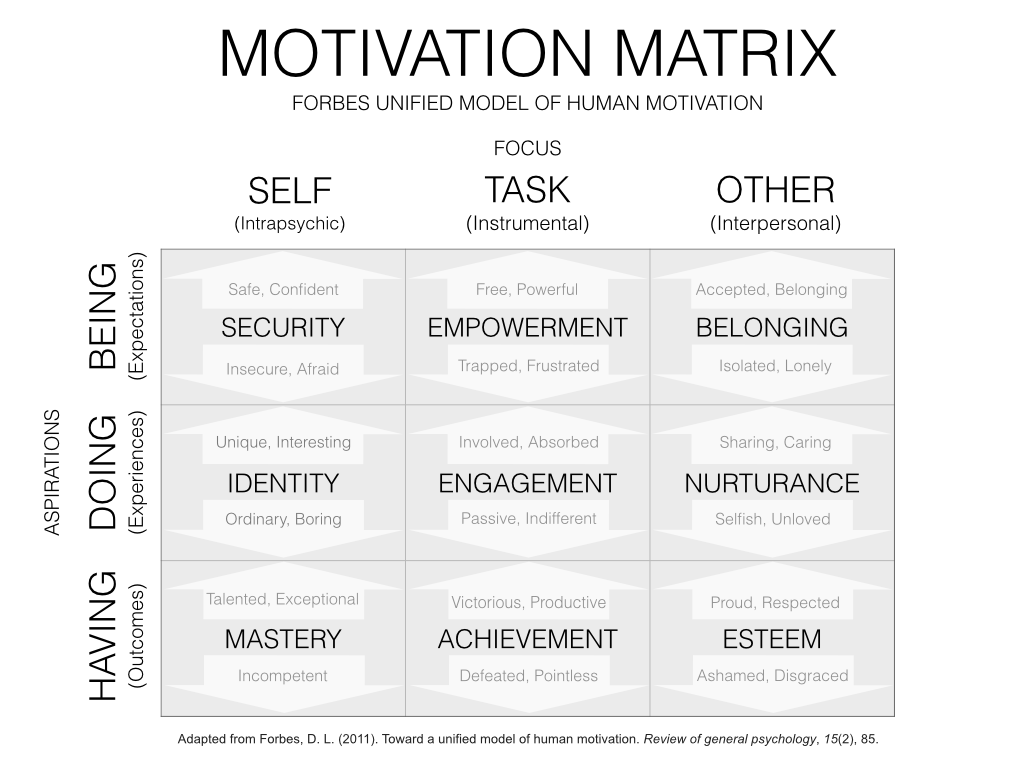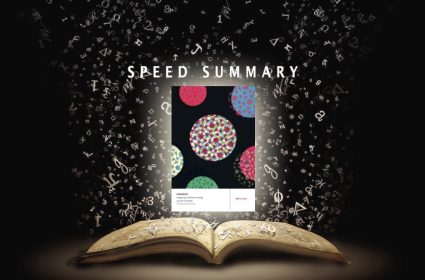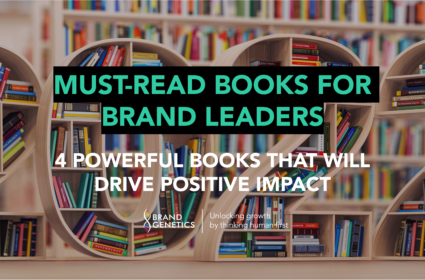The Science of Why [Speed Summary]

- The Science of Why: Decoding Human Motivation and Transforming Marketing Strategy
- Author: David Forbes
- Publisher: Palgrave Macmillan
- Publication date: 2015
For marketers, what motivates consumers matters. Why? Because motivation is what drives consumers to buy; motives are psychological tension states that push us to act – the ‘why’ behind what we buy. But there’s a problem. Motivational research is a mess; a disjointed bundle of findings and theories still peppered with 1950’s pyramids (Maslow) and phalli (Freud).
In the The Science of Why, psychologist and market researcher David Forbes sets out to put things right and make motivational research make sense. The hero of the show is the motivational matrix, a distillation of research from a range of sub-disciplines in psychology (cognitive, positive, psychodynamic…) into nine core psychological motivations across two dimensions – focus and aspiration.

Intrapsychic Motivations: Self-focused drive (autonomy)
- Security: To be safe, confident, free from worry – manifests itself as desire for safety, protection, confidence, and personal peace. When motivated by security, we seek validation, reassurance, reinforcement, and/or freedom from worry
- Identity: To do things that reflect our personal taste, style, and values. Our drive to act as ourselves and express our individuality. When motivated by identity, we seek to express personal tastes, values, and styles that define us as a particular individual
- Mastery: To have full actualization of our personal talents and strengths, striving for distinctive outcomes of the self. When motivated by mastery, we seek to realise the fullness of our potential as a person, includes aspirations for excellence, expertise, perfection, control, organization and understanding
Instrumental Motivations: Task-focused drive (competence)
- Empowerment: To be equal to the task, capable, and free to act. When motivated by empowerment, we strive for feelings of permission, capability, and entitlement that allow us to feel free to take a chosen or desired course of action
- Engagement: To do all the activities of my life in a way that feels great— exciting, productive, absorbing. When motivated by engagement, we seek to optimize the experience of actions in process, to make the experience of living as inherently rewarding as possible—absorbing, exciting, productive, or just plain fun
- Achievement: To have good results from our life’s activities, and outcomes of which we can feel proud. When motivated by engagement we strive for completion, success, triumph over adversity, and pride in a job well done
Interpersonal Motivations: Other-focused drive (relatedness)
- Belonging: To be connected with relationships to other people in our world. When motivated by belonging we seek acceptance, affiliation, community, kinship, partnership, and friendship
- Nurturance: To do things with others that make us feel good through loving, liking, caring, and cooperating. When motivated by nurturance, we long for feelings of empathy, love, affection, caretaking, kindness, support, consideration, understanding, cooperation, and collaboration
- Esteem: To have a standing in our social network that results in respect and admiration. When motivated by esteem we strive for outcomes that include respect, integrity, responsibility, leadership, and moral authority
For a summary of the framework, see Forbes, D. L. (2011). Toward a unified model of human motivation. Review of general psychology, 15(2), 85.
For Forbes, clearing up motivation mayhem is not a matter of intellectual neatness, it’s about putting motivational research back to the heart of innovation and marketing. Only by understanding the inherently rewarding intrinsic motivations that drive consumer behaviour can we build products, services and campaigns that cut through the clutter and connect with us emotionally. The value of motivations is that they lead to purchase motivation, rather than mere purchase interest. Motivations are the drivers of emotional attraction and frustration that move us to buy.
The Brand Genetics Take
The Science of Why is a must-read for any business looking to develop products, services and campaigns that have deep psychological appeal. Of course, there are many ways to skin the motivational cat, from intrinsic/extrinsic motivation (inherently rewarding vs. rewarding consequence) to Herzberg’s two-factor theory (motivators vs. hygiene factors) to the ARC of self-determination theory (autonomy, relatedness, competence), the APA of need theory (achievement, power, affiliation), to flow theory, self-efficacy theory and expectancy-value theory. And that’s before you turn to the core human values that motivate us such as the LOV 9 – list of values (self-respect; self-fulfillment; accomplishment; well respected; fun and enjoyment; excitement; warm relationships; belonging; security).
But what The Science of Why offers is a coherent, integrated and practical framework that is broad enough to allow for nuance, subtlety and differentiation, but simple enough to guide real-world thinking and inform decisions. We particularly like the classification of motives according to their focus, which fit broadly along the the lines of the ARC from self-determination theory – Autonomy (self-focus), Relatedness (other-focus), Competence (task focus).
As researchers, the one thing we missed in the Science of Why was a clear steer on how Forbes sees needs, drive, values and motivations differing from each other and relating to each other in market research. In the research world, the terms are often used interchangeably, and this can result in confusion. It would have been useful to enjoy the same Forbes-style clarity that was applied within the field of motivation applied to how motivational research fits within the broader context of research into needs, motivations and drive. But it’s unfair to criticise a book for what it didn’t say. As it stands, the Science of Why is the new must-read for businesses and researchers interested in why people buy.




